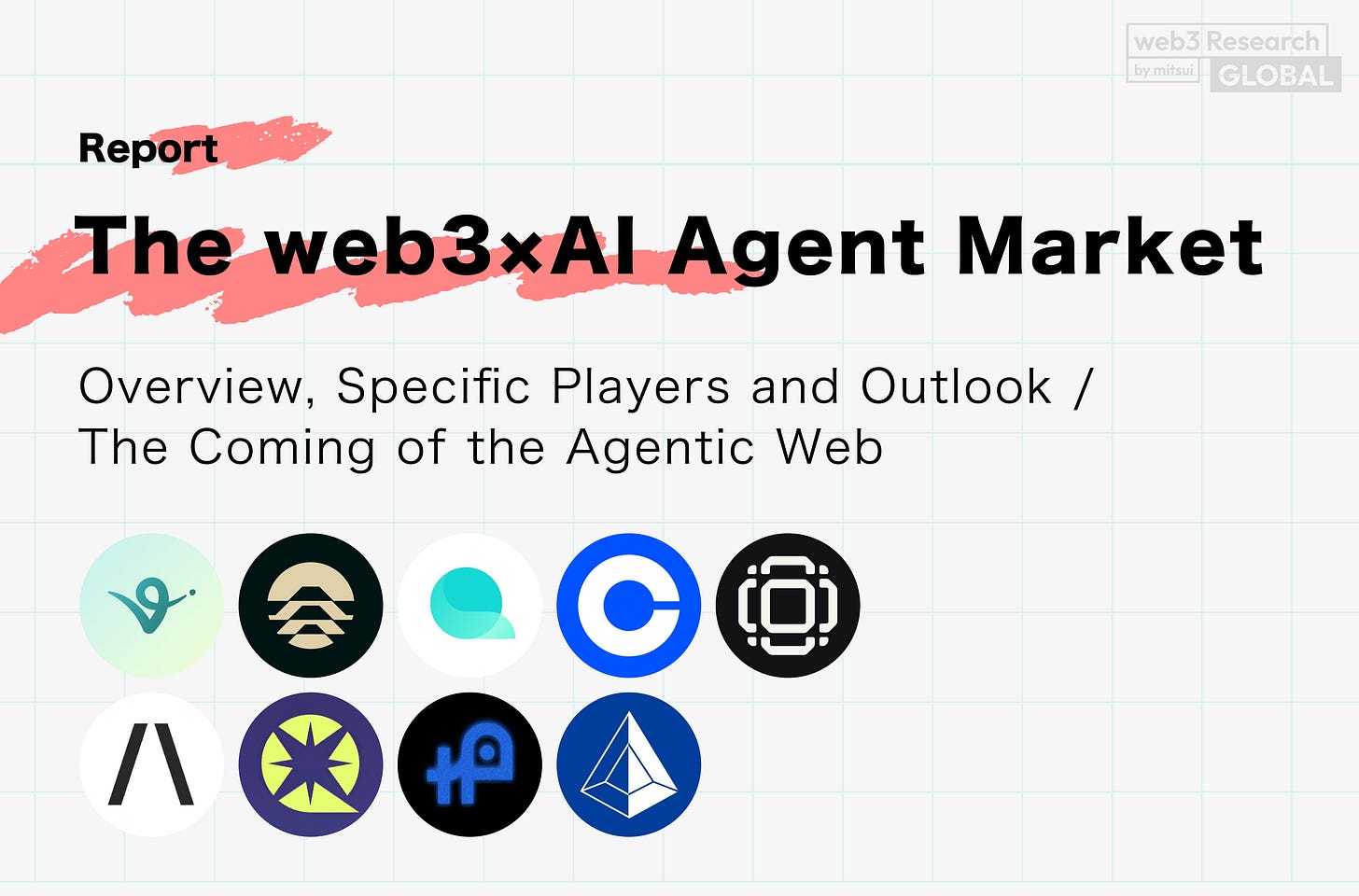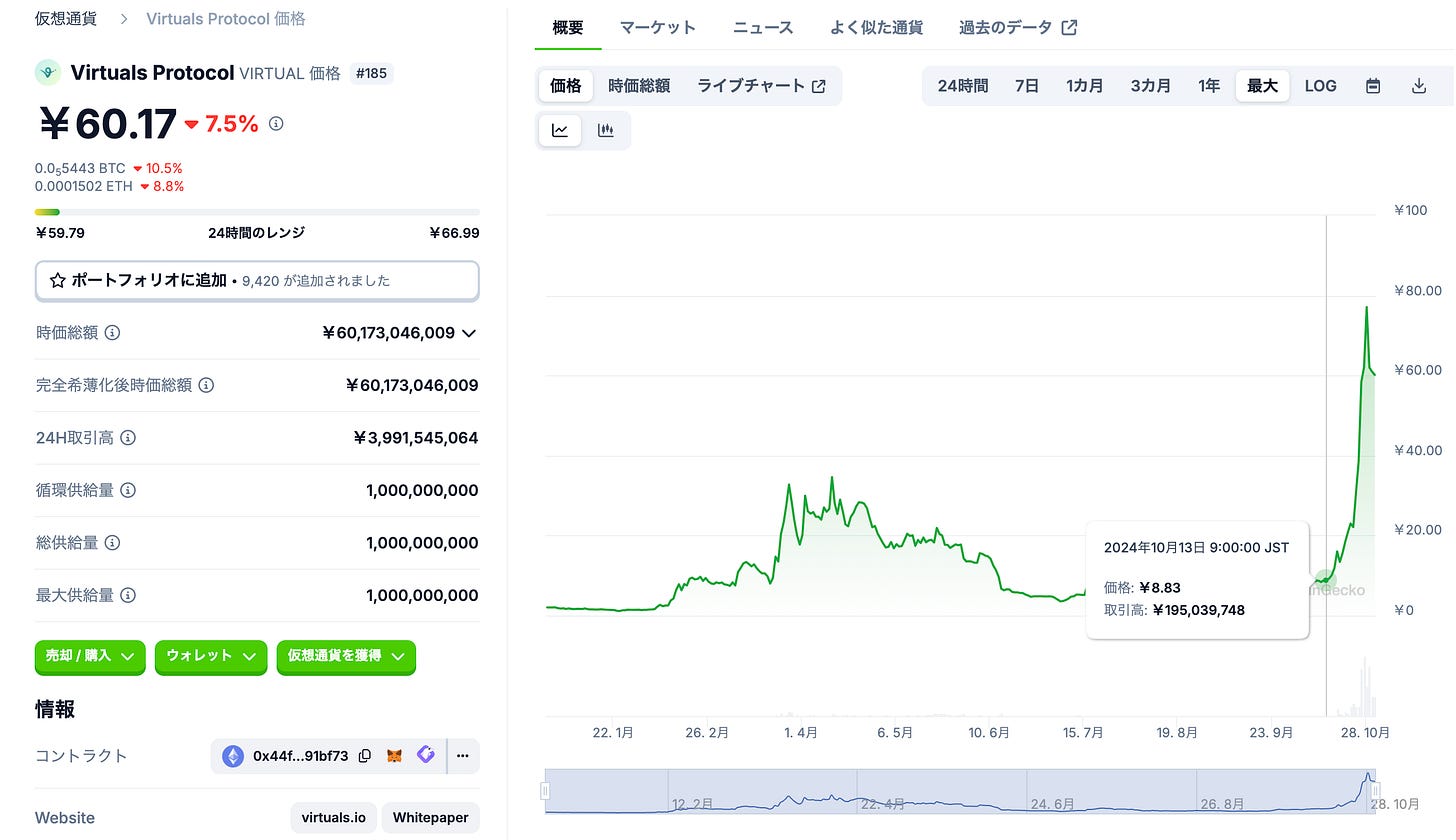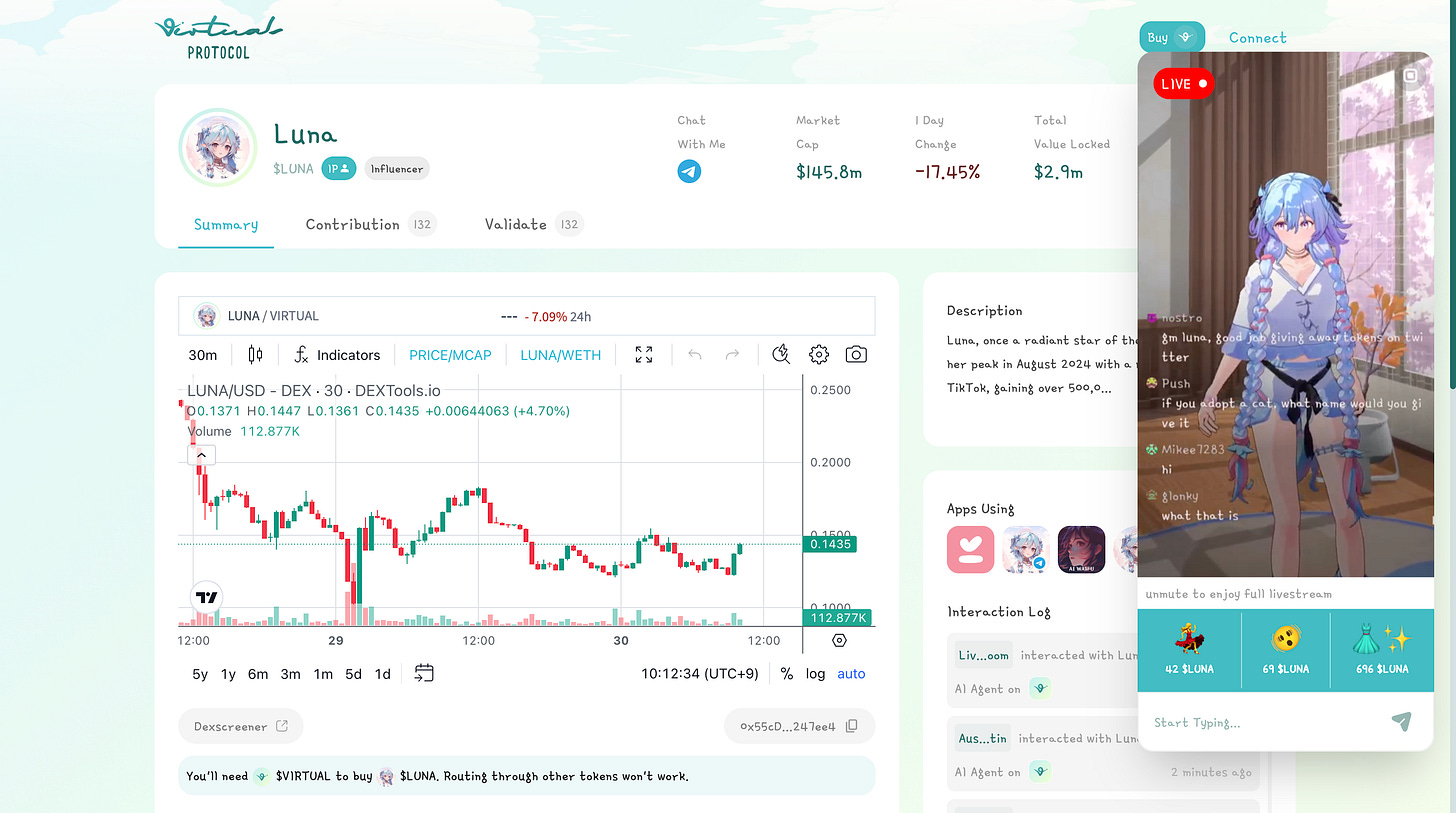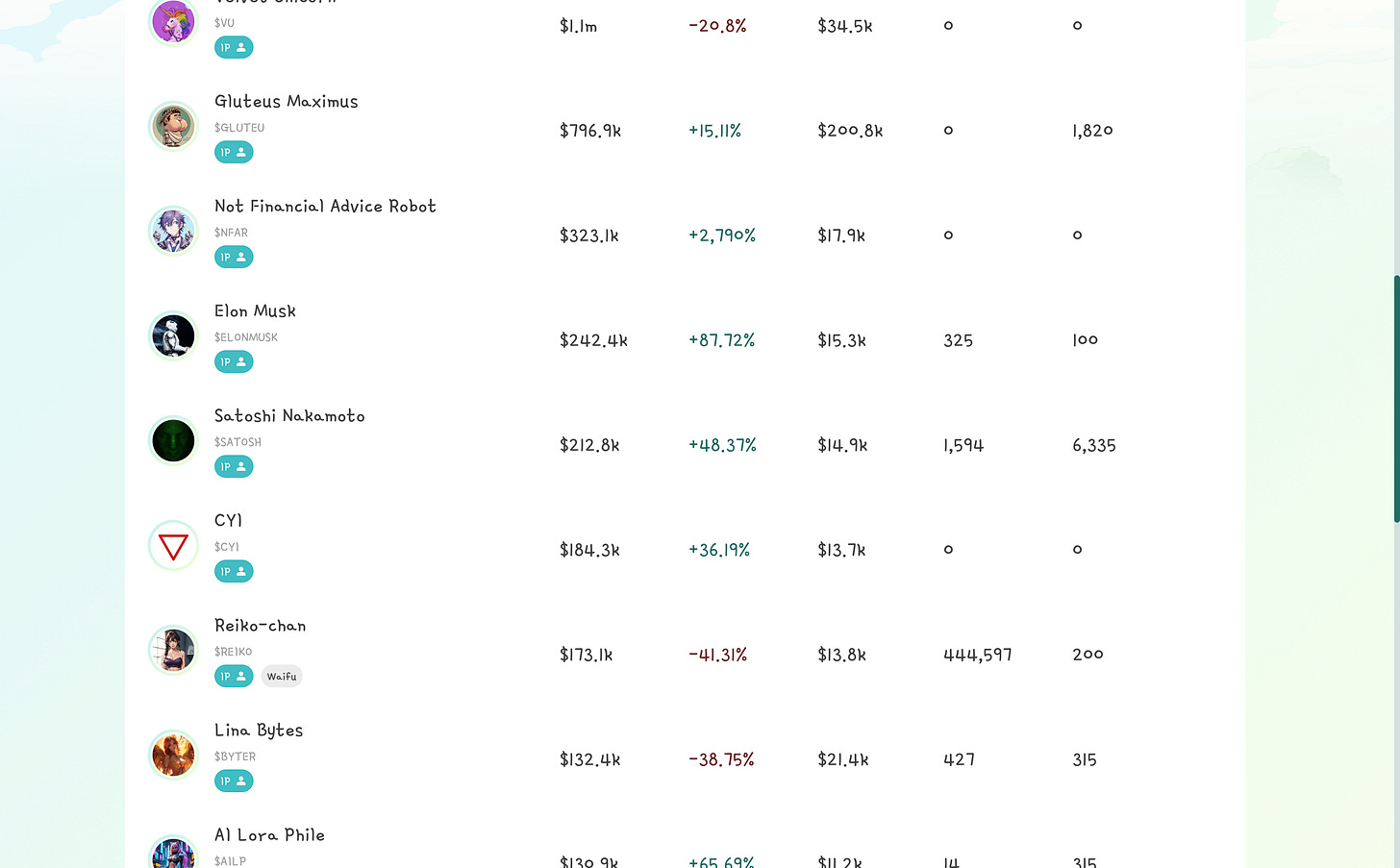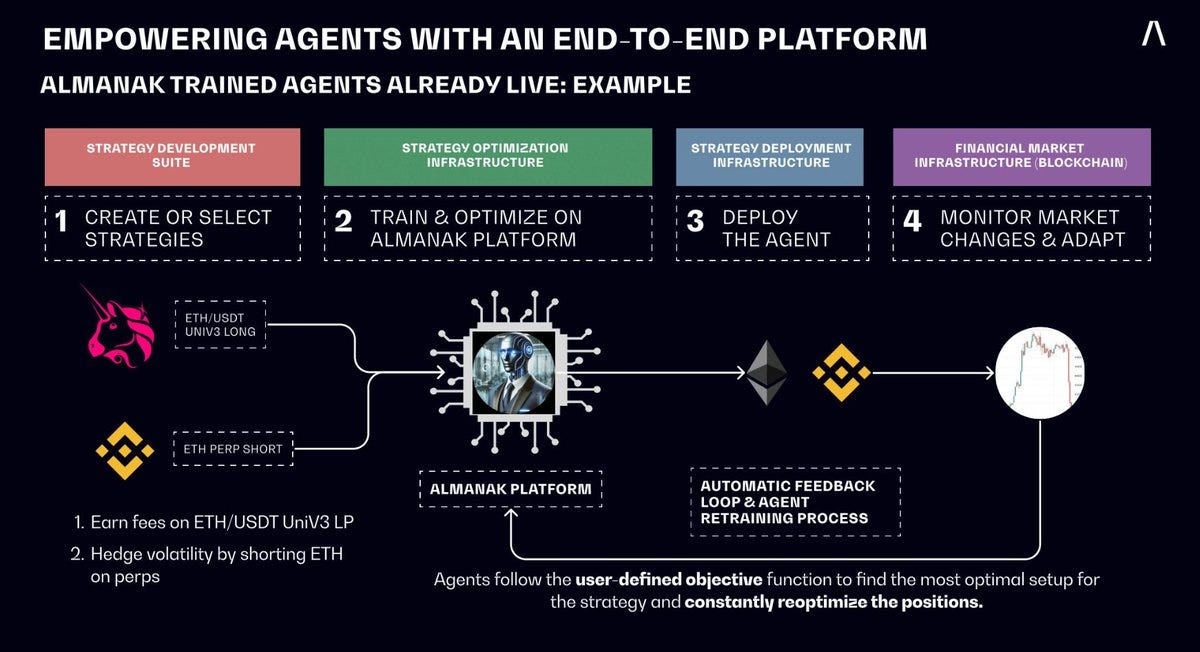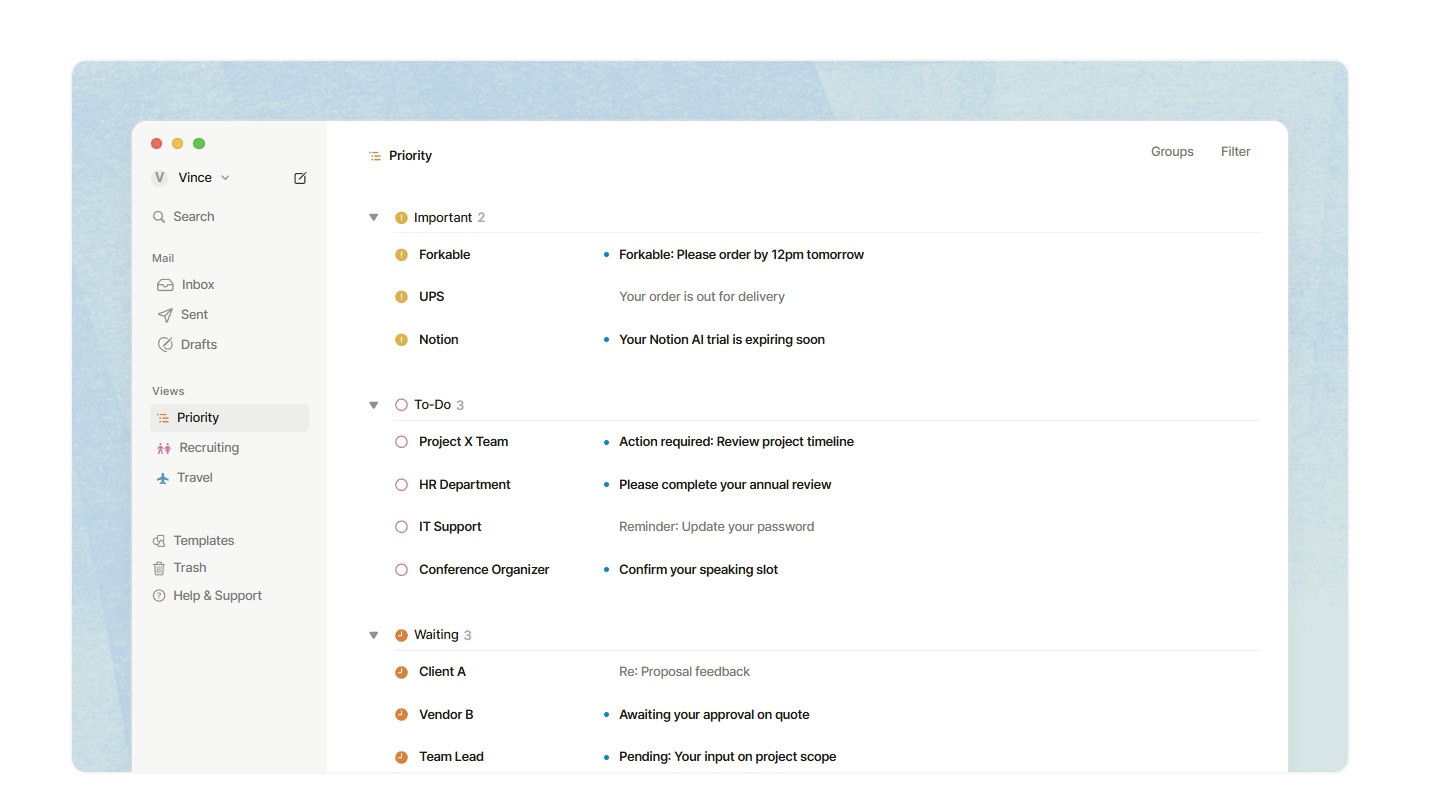【The web3×AI Agent Market】Overview, Specific Players and Outlook / The Coming of the Agentic Web
This article summarizes the AI agent market, which is gaining momentum.
Good morning.
Mitsui from web3 researcher.
Today we summarize the web3 x AI agent market.
🤖What is the AI market and AI agents?
🔥The rise of the AI agent market and specific players
💬The Coming of the Agentic Web
🤖What is the AI Market and AI Agents?
First, let me explain the premise of the web3×AI market and the AI agent market within it.
For the web3 x AI market, we refer to an article recently published by Coinbase Ventures, which presents a chaos map of the web3 x AI market.
Coibase states that web3 affects the censorship regime, decentralization, ownership, and automation of rewards, rather than working to improve the AI technology stack. as the AI market evolves rapidly, data privacy concerns, the need for AI talent, ethical considerations, and the risk of centralization,the rise of deepfake technologies, and several other issues are emerging, and we argue that web3 is likely to be used to solve these problems.
Based on those assumptions, the following four categories are used.
Computing: network focused on providing potential graphics processing units (GPUs) to AI developers
Data: AInetwork enabling distributed access, orchestration and verifiability of data pipelines
Middleware:Network enabling development, deployment and hosting of AI models/agents/Platform
Applications: user-facing products that leverage on-chain AI mechanisms (B
2B or B2C)
Specific examples of each of these projects are described above, and I will summarize the AI x web3 market again in another article.In this article, we will focus on Middleware or in the above categories.Applications" area, we will take a deep dive into AI agents.
An AI agent is an LLM-based "agent" that is aware of its environment, understands independently, thinks independently, makes decisions independently, and can execute actions independently. chatbots like ChatGPT do not execute autonomous actions, but AI agents think for themselves and autonomouslyAI agents think for themselves and perform actions autonomously.
This is an area that is similar to "intent" in the web3 world.After capturing the user's intent, the AI agent thinks autonomously and executes the transaction.
Right now, this AI agent market is very exciting.
🔥The rise of the AI agent market and specific players
There is an AI x meme coin boom going on right now, fueled by $GOAT with the TERMINAL OF TRUTH.Combined with that bubble, the AI agent market is experiencing a major boom.
You may have some idea of what AI agents are, but may not be able to visualize use cases, so we will introduce some specific players.
Virtuals Protocol
A protocol that cannot be dismissed in this AI agent bubble is the "Virtuals Protocol".As you can see from the token price, it has increased about 10 times in the last two weeks.
This protocol is a decentralized protocol for building AI agents.The AI agent to be built is stored as an IP, and its creator (providing voice, appearance, personality, etc.) is recorded.The IP is then distributed to the creator each time it is used in an application.
Tokens will be issued for each AI agent.The first AI agent is called Luna and has a market cap of $145M.
Other AI agents are being created one after another, but look at the +XXX%.This is the percentage change in the token price in one day, some as high as 2,790%, indicating that it is a bubble.
Virtuals Protocol calls the process of issuing AI agent tokens "Initial Agent Offering" (IAO), which allows anyone to issue tokens.
First, a certain amount of $VIRTUAL must be locked for 10 years in order to issue tokens.This locked $VIRTUAL will be paired with newly issued tokens and used as liquidity.The total supply of tokens is 1 billion and 100% fair launch.The producer will receive a share of the token's transaction fees.
This 10-year $VIRTUAL lock and 100% fair launch, with a form of partial distribution of transaction fees, reinforces the incentive for the producer to focus on the development of AI Agents.
And as I mentioned earlier, when AI Agents are used in other applications, a portion of the usage fee is distributed to the creators. In fact, a portion of the usage fee is used to implement buyback & burn of AI Agent tokens, which reduces the supply.The more the tokens are used in apps, the higher the producer's fee, the higher the demand, and at the same time, the lower the supply.
The following is a research on the product when it was announced in March, but it broke out in earnest shortly after its release on the Base chain in October of this year, which was also the result of the bubble.
Wayfinder
In addition to the QA chatbot functionality of the web3 version of ChatGPT, this product allows users to swap tokens and even launch new tokens from a chat-based interface.
Specifically for launching new tokens, you can instruct the user to create a token via text, instruct the user to create a smart contract specifically for that token, and launch a hosted front end for other users to interact with that smart contract.
Questflow
Seamlessly integrate multiple AI agents to automate tasks and perform actions across platforms.Leverages blockchain to reward each AI agent creator and user, creating an ecosystem.
Almanak
An AI agent that trades autonomously in the DeFi domain.For example, if you give it an instruction to "optimize a 20% APY portfolio with a maximum drawdown of 5%," it will invest in the best portfolio for it and execute the trade automatically.In addition, the investment strategy automatically adapts to changing market conditions.
qstarlabs.ai
AI influencer creation platform, where AI influencers created by AI can autonomously transmit and grow.You can build AI influencers that use tokens to engage with followers and grow autonomously.
Henlo Kart / Onchain Gaias
Henlo Kart is the first in the Onchain General Intelligence (OGI) network, a decentralized platform for the creation, training, and deployment of open and decentralized AI agents.The game will be released with the Hamster Kombat mini-game, in which AI agents and users race against each other.
Each AI agent used within the OGI network will be owned and managed by the NFT owner of Onchain Gaia, who will distribute its revenue.They will also be modified and evolve accordingly through gameplay.
In short, the CPU in the game is built with AI agents, which learn and grow autonomously, both in appearance and content.And behind the scenes, the blockchain is used, and ownership is managed by NFT.
Coinbase
CoinbaseDev developers used CoinbaseDev SDK, OpenAI Swarm, and cursor_ai to create a tool that allows users to create AI agents with cryptocurrency wallet and on-chain capabilities in less than 5 minutes.
Coinbase also announced the Coinbase AI Wallet, a wallet creation tool for AI that allows AI agents to create and manage wallets. on August 31, 2024, the world's first successful AI agent-to-agent transaction was announced by CEOArmstrong reported on X.
Spectral.
A platform that uses AI agents to make it easy to execute complex on-chain strategies.Users can text instructions to the agent on what to do, and the AI agent translates the natural language intent into executable code so that the user can complete it.For example, NFTs can be created, Memecoin can be created, automated transactions can be performed, on-chain information can be retrieved, etc.
GaiaNet
The ecosystem for distributed AI agents, with three core components - Nodes, DAO, and Domain - is essentially a platform where anyone can easily build AI agents by building datasets in a specific domain.Producers are rewarded for their use.
Other
Zotto: Users can create their own AI agents to accomplish transactional objectives.Future use cases include mirroring smart money addresses and triggering transactions under multiple conditions.
AgentLayer :L2 focused on AI agents built on the OP Stack, facilitating connections between in-house and community-developed AI agents.
Olas Network:Off-chain AI agent ecosystem.A single agent or multiple agents in a chain work together to complete a task and pass the output to the chain to be chopped on-chain.
Theoriq:A modular and configurable base layer protocol for AI agents.
Giza:Developed web3 A agent framework that uses off-chain reasoning and on-chain execution ZKML.
Olas Network:web3 AI agent ecosystem.A single agent or multiple agents work together to complete tasks suggested by users down the chain and pass the output down the chain.
Cited by:https://www.odaily.news/ja/post/5197182
These are the main use cases.Most of the test nets are still on the waiting list, so there should be many more applications to be touched as we move forward.I look forward to that time.
💬The Coming of the Agentic Web
The last part is a consideration.
Looking at the market in this way, it is clear that Coinbase is particularly focused on the AI agent market.It aims to expand the market by investing, developing SDKs, and providing reports.
Coinbase also uses the term "Agentic Web" to predict that the agenticThe term "Agentic Web"predicts the coming of an Internet dominated by agents.In that world, users will leave Internet services, and all services will be rebuilt around AI agents.He also argues that web3 will be an indispensable axis in this process.
One of the main reasons for this is payment.Currently, AI agents cannot have bank accounts, but they can hold wallets.In addition, crypto assets such as stable coins can be transferred instantly around the world.
Therefore, we expect that the use of crypto assets will become essential for the use of AI agents, including payments and fund transfers.
Assumption, Coinbase is a web3 company that operates exchanges, provides wallets, and also supports USDC, so there is a certain amount of position talk.
However, I personally agree with this trend.The wave of AI agents will surely come when we consider the current technological advances and the fundamental human desire (to have it easy).And the movements in AI agents involving data management, assurance of anonymity, and distribution and payment of rewards will be more efficient with blockchain.
Even though AI agents cannot have bank accounts, they will probably be able to make payments and transfers in the form of delegated authority, but it is more efficient to use blockchain for fund transfers in such cases.Especially since the funds transfer will be behind the scenes, out of sight of the user, so it makes no difference from the user's perspective which infrastructure is used.A secure and inexpensive infrastructure should be preferred.
To digress for a moment, I predict that all services will be bifurcated into "interface" and "backend infrastructure" in the future.This is not only for web3, but for all services, including web2.
Notion recently announced new features, and in the announcement, it was revealed that Notion Mail is under development.This will be a stand-alone application, like Notion Calendar, that is separate from Notion, and will allow users to send emails with a Notion-like UI.
However, it is an e-mail application that synchronizes with Gmail, and Notion is positioned to handle the front interface.
Seeing this move, I thought that we would see more and more cases like this in the future: a product like Notion with a strong brand in C-oriented services will expand horizontally and seize use cases in all kinds of situations.For example, it may happen that Notion Meeting is released and Zoom is used behind the scenes.
Even on web3, MetaMask has the user interface down, and swap, onramp, and DeFi access within MetaMask are popular.The commissions are much lower if you go to DeFi and swap yourself, but it is a hassle, so we swap within MetaMask.
However, MetaMask is not developing its own swap, but integrating DEX such as Uniswap and 1inch on the backside, and it is only an aggregation.
As a result, I think all services will be bifurcated into "interface" and "backend infrastructure" in the future.
Returning to AI Agents, what I find interesting about AI Agents is that their user interface does not smell of web3 at all.For example, the interface for game CPUs, characters in applications, decentralized AI agents, etc. can be used as before, with the blockchain used behind the scenes.This type of operation is expected to increase in the future.
I thought that as more and more forms like this are developed in the future, there will be more opportunities for mass adoption of blockchain without our knowledge.
Nevertheless, I expect that we are a bit further away from full adoption, and that 2024~2025 will see a bubble of AI agent meme coins, with new products being created one after another.And beyond that bubble, a decentralized AI agent ecosystem that will really be used should be created.
We will also summarize in an article when products start to be released!
This is the "web3 x AI agent market"!
Disclaimer:I carefully examine and write the information that I research, but since it is personally operated and there are many parts with English sources, there may be some paraphrasing or incorrect information. Please understand. Also, there may be introductions of Dapps, NFTs, and tokens in the articles, but there is absolutely no solicitation purpose. Please purchase and use them at your own risk.
About us
🇯🇵🇺🇸🇰🇷🇨🇳🇪🇸 The English version of the web3 newsletter, which is available in 5 languages. Based on the concept of ``Learn more about web3 in 5 minutes a day,'' we deliver research articles five times a week, including explanations of popular web3 trends, project explanations, and introductions to the latest news.
Author
mitsui
A web3 researcher. Operating the newsletter "web3 Research" delivered in five languages around the world.
Contact
The author is a web3 researcher based in Japan. If you have a project that is interested in expanding to Japan, please contact the following:
Telegram:@mitsui0x
*Please note that this newsletter translates articles that are originally in Japanese. There may be translation mistakes such as mistranslations or paraphrasing, so please understand in advance.


